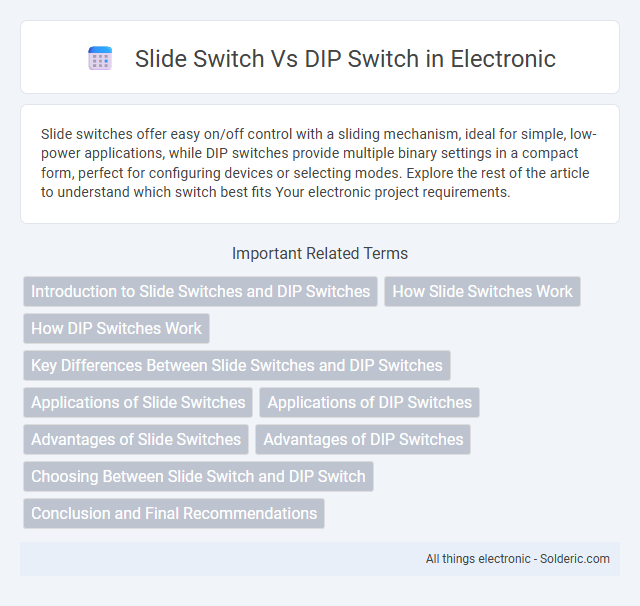Slide switches offer easy on/off control with a sliding mechanism, ideal for simple, low-power applications, while DIP switches provide multiple binary settings in a compact form, perfect for configuring devices or selecting modes. Explore the rest of the article to understand which switch best fits Your electronic project requirements.
Comparison Table
| Feature | Slide Switch | DIP Switch |
|---|---|---|
| Function | Single switch with sliding actuator | Multiple switches in one package for binary data input |
| Number of Poles | Usually Single Pole or Double Pole | Multiple Single-Pole Switches (typically 2 to 12) |
| Actuation | Slide lever moves horizontally | Small rocker lever toggles ON/OFF positions |
| Application | Power control, mode selection | Address setting, configuration, calibration |
| Mounting | Through-hole or surface mount | Through-hole predominantly |
| Size | Compact, single unit | Larger due to multiple switches |
| Switching Positions | Typically 2 positions (ON/OFF) | Multiple ON/OFF positions (per switch) |
| Typical Voltage Rating | Up to 125 VAC or 30 VDC | Up to 24 VDC |
| Durability | 10,000 to 30,000 cycles | Up to 100,000 cycles |
| Cost | Medium | Low to Medium, depending on number of poles |
Introduction to Slide Switches and DIP Switches
Slide switches and DIP switches serve as fundamental components for controlling electronic circuits by enabling manual input selection. Slide switches offer a simple sliding mechanism for easy on/off or multi-position control, often used in portable devices for quick toggling. DIP switches consist of a series of tiny switches in a dual in-line package, allowing multiple binary settings for configuring devices like motherboards, providing durable, reliable hardware-level options for your electronic projects.
How Slide Switches Work
Slide switches operate by sliding a movable actuator to open or close electrical contacts within the switch housing, enabling or interrupting circuit flow. The sliding mechanism shifts a metal contact bridging terminals, providing a simple, reliable way to toggle between on/off or multiple circuit positions. Common in low-voltage applications, slide switches offer tactile feedback and compact design, making them suitable for consumer electronics and control panels.
How DIP Switches Work
DIP switches function by providing multiple small mechanical switches packaged in a dual inline format, allowing for easy binary on/off settings within electronic circuits. Each switch controls a circuit connection, enabling customization and configuration directly on the hardware without software intervention. Your projects benefit from DIP switches' simplicity and reliability in setting device addresses, modes, or options efficiently.
Key Differences Between Slide Switches and DIP Switches
Slide switches and DIP switches differ mainly in their design and application; slide switches feature a single actuator that moves linearly to open or close a circuit, while DIP switches consist of multiple small switches in a dual in-line package allowing individual control of each circuit. Slide switches are commonly used for single, straightforward on/off control in devices, whereas DIP switches are ideal for configuring settings or addressing options on PCBs with multiple position options. Your choice between the two depends on the complexity of your circuit and the need for compact, multi-switch configurations versus simple binary switching.
Applications of Slide Switches
Slide switches are commonly used in consumer electronics such as flashlights, audio equipment, and small appliances due to their simple on/off control and compact design. Their reliability in low-voltage applications makes them ideal for handheld devices and toys, where quick manual operation is essential. You can find slide switches in settings where durability and ease of use are crucial, as they offer tactile feedback and straightforward functionality.
Applications of DIP Switches
DIP switches are widely used in electronic devices for setting configurations on circuit boards, such as selecting device modes, configuring hardware addresses, and enabling or disabling features in embedded systems. They are commonly found in network equipment, remote controls, and industrial machinery where reliable and manual configuration is essential. Compared to slide switches, DIP switches offer compactness and the ability to manage multiple binary options simultaneously, making them ideal for space-constrained applications requiring precise control settings.
Advantages of Slide Switches
Slide switches offer compact size and ease of operation, making them ideal for small electronic devices where space is limited. Their smooth sliding mechanism provides reliable tactile feedback and reduces wear, enhancing durability compared to DIP switches. You benefit from quick, intuitive switching without the need for specialized tools or detailed alignment, improving user experience and assembly efficiency.
Advantages of DIP Switches
DIP switches offer compact size and easy integration into circuit boards, providing reliable, low-cost manual configuration options without requiring software changes. You benefit from their durability and consistent mechanical operation, which ensures stable settings in environments with vibration or electrical noise. Their straightforward design allows quick identification and modification of switch positions, making DIP switches ideal for customizable hardware configurations.
Choosing Between Slide Switch and DIP Switch
Choosing between a slide switch and a DIP switch depends on your project's space constraints and required functionality. Slide switches offer easy manual control and are suitable for single-pole, single-throw applications, whereas DIP switches provide multiple settings in a compact form ideal for configuring hardware options. Your decision should consider factors like circuit complexity, user interface preference, and installation environment to optimize device performance.
Conclusion and Final Recommendations
Slide switches offer easy, quick toggling ideal for frequent manual operations, while DIP switches excel in setting configurations that rarely change and require compact, reliable binary control. For applications demanding accessible, user-friendly interface, slide switches are recommended; conversely, DIP switches suit embedded systems and hardware configurations where space efficiency and stable settings are crucial. Choosing between slide and DIP switches depends on usage frequency, design constraints, and the need for reprogrammability or fixed setup.
slide switch vs DIP switch Infographic

 solderic.com
solderic.com